
{ Practical astronomy | Astronomy | Planets }
The planets
When the Sun formed out of the interstellar gas and dust of the Milky Way galaxy about 4.6 Gyr ago, this involved an accretion disc that has not entirely disappeared. Before this material could be dispersed by solar radiation, the planets formed and remain in orbit around the Sun. The inner regions were hotter and lost the gas sooner, leading to different types of planet: The four innermost planets (Mercury, Venus, Earth and Mars) are small and rocky, followed by two large gas giants (Jupiter and Saturn) and two, not quite as large, ice giants (Uranus and Neptune). All these still orbit close to the plane of the original accretion disc. We call this the ecliptic, which is more strictly the name for the orbital plane of the Earth.
| a Gm |
P yr |
e |
i ° |
T K |
R km |
ρ kg·m−3 |
α |
ε ° | ||
|---|---|---|---|---|---|---|---|---|---|---|
| 1 | Mercury | 57.9 | 0.24 | 0.2056 | 7.0 | 100–700 | 2439 | 5400 | 0.14 | 0.03 |
| 2 | Venus | 108.2 | 0.62 | 0.0068 | 3.4 | 740 | 6052 | 5200 | 0.69 | 177 |
| 3 | Earth | 149.6 | 1.00 | 0.0017 | 0.0 | 185–330 | 6378 | 5500 | 0.43 | 23 |
| 4 | Mars | 227.9 | 1.88 | 0.0934 | 1.8 | 130–310 | 3397 | 3900 | 0.17 | 25 |
| 5 | Jupiter | 778.3 | 11.9 | 0.0484 | 1.3 | 165 | 71492 | 1300 | 0.54 | 3 |
| 6 | Saturn | 1426.7 | 29.5 | 0.0539 | 2.5 | 135 | 60268 | 690 | 0.50 | 27 |
| 7 | Uranus | 2870.7 | 84.0 | 0.0473 | 0.8 | 80 | 25559 | 1300 | 0.49 | 98 |
| 8 | Neptune | 4498.4 | 165 | 0.0085 | 1.8 | 70 | 25269 | 1600 | 0.44 | 28 |
As one expects, the surface temperatures decline with distance from the Sun. Venus is uncharacteristically hot due to its unusually dense and opaque atmosphere. The inner four, rocky planets have orbits spaced by 60 Gm on average, for the gas and ice giants the number is more like 1500 Gm. Similarly, the rocky planets are small at a few thousand km radius, the gas giants are ten times larger, the ice giants five times. The mean density goes the other way, which reflects the absence or presence of gas during formation: The rocky planets have the density of rock, the gas and ice giants more that of water. The gas and ice giants have similar albedo, reflecting about 50% of incident light. Venus surpasses this, Earth almost matches it. Mars and Mercury reflect not even twice as well as coal. This is due to their rock surface. But Earth is covered mostly by water and Venus is shrouded in its bright and reflective atmosphere.
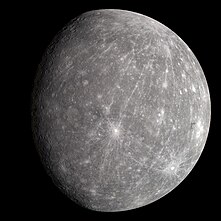
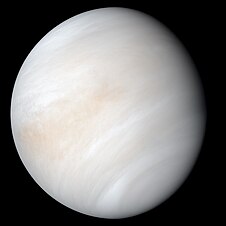
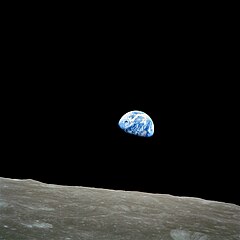
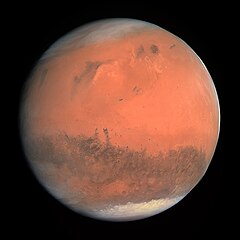
The rocky planets in true colour, imaged by visiting spacecraft.
1: Mercury by Messenger in 2008 (NASA et al. 2008a).
2: Venus by Mariner 10 in 1974 (NASA et al. 1974a).
3: Earth rising in lunar orbit, from Apollo 8 in 1968 (Anders/NASA 1968a).
4: Mars by Rosetta in 2007 (ESA/OSIRIS 2007a).
The orbits of Venus, Earth and Neptune are close to circular with eccentricities below 0.01. Mercury has the highest eccentricity of 0.2, followed by Mars with 0.1. Jupiter, Saturn and Uranus are moderate at about 0.05 and similar in this respect. Mercury also has the most extreme inclination of the orbit against the ecliptic, followed by Venus and Saturn.
Half the planets' rotation axes are inclined to the ecliptic by about 25°, creating seasons similar to Earth. Three planets are nearly upright (Mercury and Jupiter; Venus is upside down and rotates retrograde). Uranus lies on its side. Mercury and Venus rotate very slowly and in resonance with their orbit; Mercury spins 1.5 times during an orbit, Venus spins 12 times in 13 orbits. Earth and Mars have similar rotation periods around 24 h. The gas giants Jupiter and Saturn spin very fast, considering their size, at 10 or 10.5 h. The ice giants are in between with about 17 h.
The planets tend to have a dense core where iron and nickel are concentrated, surrounded by a less dense mantle. The mantle is rock in the rocky planets, liquid hydrogen and helium in the gas giants, and a liquid mix of water and ammonia in the ice giants. The rocky planets have a thin solid crust. The Earth, in addition, has the water oceans. Earth and Mars have seasonal ice caps at the poles. The atmosphere of the rocky planets is thin compared to the size of these planets. The gas and ice giants have no solid surface; their visible surface is the tropopause, where the pressure is about 1000 hPa. Hydrogen and helium are rare in the atmospheres of the rocky planets, but in the gas and ice giants the atmosphere is essentially primordial with 75% hydrogen and 25% helium by mass. The ice giants have more water, ammonia and methane in their atmospheres than the gas giants do.

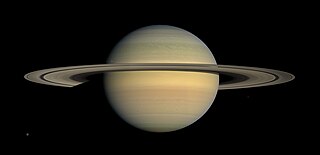

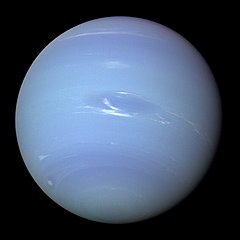
The gas and ice giants in true colour.
5: Jupiter imaged by the Hubble Space Telescope in 2014 (Simon et al. 2014a).
6: Saturn imaged by Cassini in 2008 (NASA et al. 2008b).
7: Uranus imaged by Voyager 2 in 1986 (NASA/JPL 1986a).
8: Neptune imaged by Voyager 2 in 1989 (Cowart et al. 2016a).
When it comes to magnetic fields, each planet is different. Such a field is usually due to a dynamo effect, i.e. convection in a conducting liquid combined with planetary rotation. Typically this is an iron-rich liquid core. The magnetic field then tends to be roughly aligned with the rotation of the planet. In the solar wind of ionised particles a planetary magnetic field develops a magnetosphere with a stronger field close to the planet on the sun-facing side and a long tail pointing away from the Sun. A magnetosphere provides some protection of the planet's surface and atmosphere from the solar wind and from cosmic rays.
Mercury has a significant, if weak field, perhaps in line with its slow rotation. The field does create a magnetosphere in the solar wind. Venus has a very weak magnetic field, which is not due to an internal dynamo but to electric interaction between the solar wind and the ionosphere.
The dynamo responsible for the Earth's magnetic field is due to convection in the iron-rich, liquid, outer core. The magnetosphere extends on the sun-facing side to the bow shock at about ten Earth radii. The magnetosphere retains charged particles such as those in the Van Allen radiation belts. During a magnetic storm on the Sun and in the solar wind, charged particles can be deflected from the magnetosphere into the Earth's ionosphere, where they excite and ionise air particles and thus cause aurora. Mars has no magnetic field, although magnetised crust material indicates that a field with polarity reversals existed in the past.
Jupiter's magnetic field is the strongest of all the planets. Responsible is a dynamo in the liquid metallic hydrogen core. The sun-facing bow shock is about 75 Jupiter radii from the planet; the magneto-tail reaches to the orbit of Saturn. The Galilean moons are within the magnetosphere and thus shielded from the solar wind. Saturn's magnetic field is of similar strength to the Earth. The bow shock is about 20 Saturn radii from the planet. The cause of the field will be the same as for Jupiter, currents in the liquid metallic hydrogen layer.
Uranus and Neptune have very peculiar magnetic fields; the axes of the dipoles are inclined some 50° against the spin axes, and the fields have strong quadrupole components.
Saturn has a very prominent ring, an orbiting layer of ice, dust and rocky debris. The particles are up to 10 m in size, while the thickness of the layer is only twice that number. The dense main rings extend from 7000 km above the planet's surface to 60000 km. The brightest rings are of similar surface brightness as the planet; the rings therefore double the apparent size of the planet. Jupiter, Uranus and Neptune also have rings or ring fragments, but those are not visible with amateur equipment from Earth.
